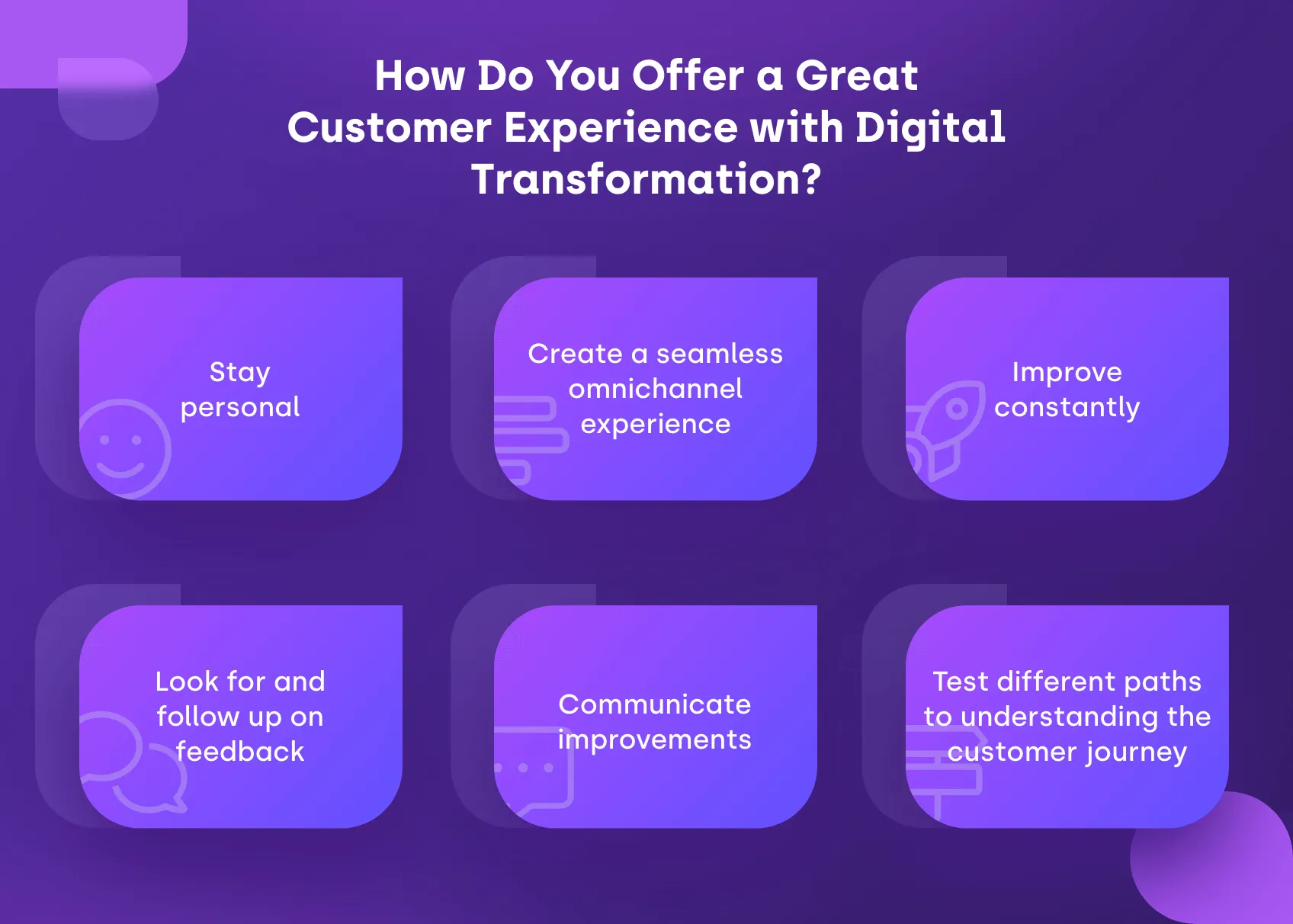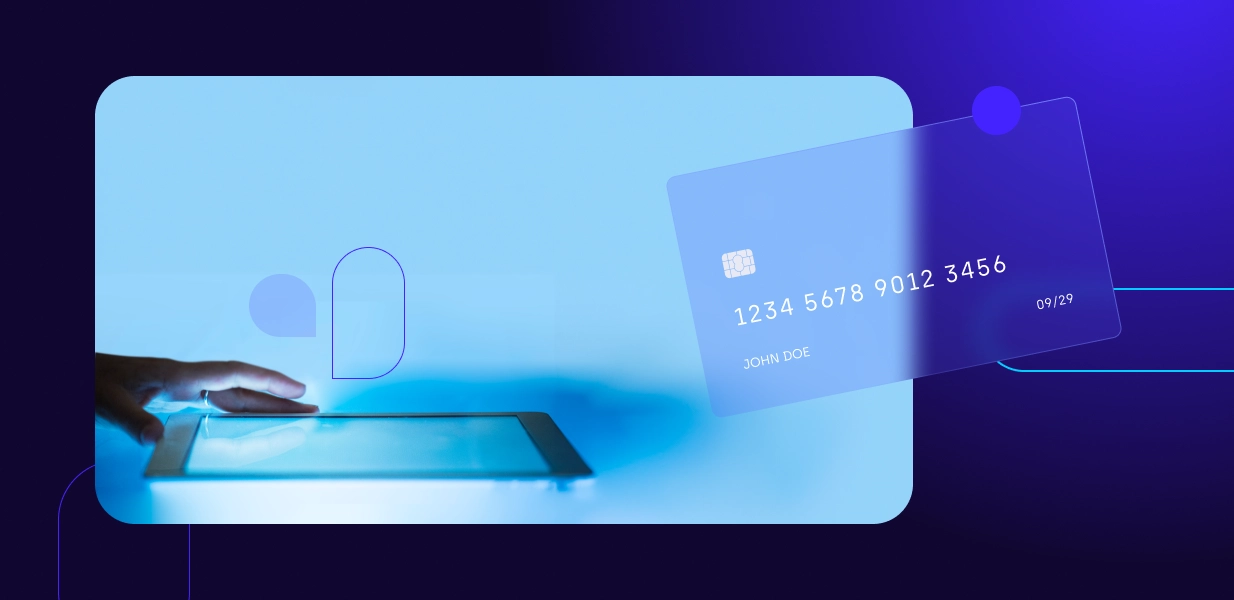
How is digital transformation improving customer experience

Digital transformation is usually framed as the transformation of a business via the adoption of digital technology to gain a competitive advantage and keep up with the times. While not wrong, this view often sounds one-directional and misses the relationship between digital transformation and customer experience and how the latter influences the change process.
Considering the other side of the coin, one could say that what’s driving the process are the customers, their shifting preferences and expectations, and their digital transformation. Technologies like machine learning, automation, AI, VR, and AR, and using several devices alongside each other, have created a massive change in customer experience (CX).
From that point of view, a company’s transformation is mainly about the service it can deliver to new customers who value their digital journey as much as the desired end result. It presents an opportunity to engage with them across many touchpoints, provide a consistent experience, and reap the long-term rewards of customer loyalty.
Here’s how companies can make sense of the new digital customer and use digital transformation to offer them an unparalleled experience!
Understanding the new digital customer experience
The proliferation of and greater access to technology means that the customer journey has changed and become more complex. Instead of reducing their interaction to a single medium, customers are more likely to switch digital channels throughout the stages of their journey. As they do so, they expect to be met at the different digital touchpoints in a seamless, personalized, and immediate way. And this is not just hearsay - companies with robust omnichannel strategies retain about 89% of their customers, compared to 33% for those with weak ones.
In a way, nothing has changed - customer experiences still need to match or exceed customer expectations. However, today’s expectations are different, one of the main factors that need to drive a company’s digital transformation strategy. And as expectations shape perceptions, digital-savvy customers rate and engage with organizations based on the digital experience they provide.
In a nutshell, today’s customer experience is online-first and constantly online, instant, and omnichannel. Fully aware of the possibilities offered by technology, customers expect brands to be there when they need them, and the point of your digital transformation efforts is to meet them.
How do you offer a great customer experience with digital transformation?
Put simply, a great customer experience can be described as one that:
- Enables the customer to complete their task and achieve their aim successfully
- Reduces the effort the customer needs to put in by offering a seamless and straightforward process
- Generates a good feeling as a result of the engagement
These three baseline conditions must be met for a digital customer experience to be considered good and desirable. These conditions are also what ultimately drive the digital transformation around customer experience. When it comes to taking practical steps, consider the following digital transformation practices as a way of continuously addressing those three conditions above:

Create a seamless omnichannel experience
CX isn’t simply omnichannel but the smoother and easier the transition is between digital touchpoints, the lower the friction is for users. As lines between online and offline become blurred, don’t forget to integrate non-digital contexts with digital ones. A consistent experience is a satisfying experience!
Improve constantly
Feel the pulse of your customer’s satisfaction and commit to playing the long game. In other words, invest in creating and increasing customer lifetime value through continuous monitoring, improvements, adaptations, and changes.
Look for and follow up on feedback
Follow up on feedback, especially of the negative kind, and communicate with those customers to right any wrong that may have occurred. This is a powerful way of connecting with them and can help build greater customer loyalty. Develop criteria for customers to serve first, as it may be difficult to respond to everyone.
Communicate improvements
Being transparent about taking in feedback and making changes is a great way to demonstrate that you are in touch with your audience. It also communicates your brand’s values, an essential point for today’s customers.
Test different paths to understand the customer journey
Don’t just wait for feedback but actively play out scenarios to discover how different people engage with your products and services and the possible pain points they may encounter.
Stay personal
Regardless of where you meet your customer, make sure that your engagement remains personal and aligned with the task they wish to accomplish at that point.
While adopting technological solutions is essential for the journey, it approaches such as the above make the journey and customer experience meaningful. Regardless of how you undergo your customer experience digital transformation, it needs to include these to remain functional.
What to keep in mind about digital transformation and the customer experience
Zooming out from specific practices, several central principles can help guide your transformation as you organize it around customer experience. These have to do with the orientation and focus of your transformation, collecting the data needed to steer the process, and taking on the responsibility for the customer experience.
People-first approach to digital transformation customer experience
Naturally, people are at the center of customer experience and any approach that seeks to improve it. With that in mind, what your transformation needs to achieve is for customers to want to use your touchpoints and features in place of any others that are available.
To begin with, this requires you to assume a company-wide approach to customer experience that integrates the front and back end rather than focusing only on the customer-facing functions. It also focuses on customer needs and desires before creating or changing your services. This means that you always need to be aware of the “why” behind pain points and dissatisfaction rather than staying at the level of the “what” and “how”.
Company-wide measurement and collaboration
As you undertake a transformation that revolves around digital customer experience, you must integrate data coming from all departments. Integrating data streams and metrics is a way of developing a shared language. Such a language is necessary for everyone to understand and be able to focus on the digital transformation goals and have a holistic view of what customer experience means.
Net promoter score (NPS), customer effort score (CES), customer satisfaction score (CSAT), and customer lifetime value (CLV), among others, are meaningful metrics to adopt in that regard. One metric is usually not exhaustive enough, so several complementing each other is recommended.
On top of such metrics, you must establish connections between digital technologies such as AI, automation, communications technologies, and various collaborative tools. Finally, you need to reconsider what employee training looks like in the context of customer experience.
The responsibility for the customer experience
Customer experience and digital transformation have their challenges regarding positioning within an organization. Is it the responsibility of marketing and sales? Does customer service cover customer experience? What’s truly transformative about shaping digital transformation around customer experience is that it introduces a whole new dimension to a company’s functioning.
For this to be the case, your digital transformation roadmap must feature specific end goals that you are aiming at. These must, of course, include adopting and implementing new technologies but only as long as these share a purpose around delivering a specific experience to customers or enabling employees to be more engaged and empowered. In this way, your organization will be responsible for the success of digital customer experience.
Current digital transformation trends that are enhancing customer experience
Of course, it’s also good to consider new digital technologies and how they may become part of your customer-facing tech stack. Following are some current digital trends companies adopt to offer an even better customer experience.
Personalizing the digital encounter
Hardly new as a concept, personalization is becoming ever more complex. When customers are recognized (you know their name), remembered (you know their purchase history), and when they receive relevant recommendations, this significantly increases the likelihood that they will return.
Automated service
Automation offers an always-available and responsive system that provides easy and fast interactions. On the business side, this increases team efficiency and saves time. And, for an even better experience, predictive AI technologies can help predict customer needs and respond to them in a personal way.
App onboarding
When done right, app onboarding helps customers understand how to best complete tasks they have in the most simple way. It also demonstrates that the app is centered around customers.
Messaging and mobile-first Interactions
Whenever personal engagement is required, customers prefer the familiarity of engaging in conversation within a messaging app of their own choice. This makes customer service simple and accessible and enables users to engage in the conversation asynchronously, whenever convenient.
Deliver excellent customer experience with Resolute Software
Resolute Software has extensive experience in helping companies undergo digital transformation. Developed over hundreds of projects, our expertise allows us to support companies in recreating their business models and processes and adopting technologies that provide lasting customer satisfaction.
Do you need help with planning and implementing your transformation? We’re here to talk! Get in touch to learn more about how Resolute Software can accompany you on your digital transformation journey!
FAQs
The integration of digital technology in a way that transforms the company and orients it toward customer expectations and experience. When implemented throughout an organization, such transformation fundamentally changes both internal business processes and the value delivered to the digital customer.
Digital transformation in customer service refers explicitly to introducing new technologies into the customer service department. It aims to improve the quality of service by making it more personal, relevant, efficient, and straightforward.
A successful digital transformation strategy provides a richer and more seamless customer experience across all digital channels and offline interactions. It can help predict customer demands and enable customers to complete their tasks and achieve their goals quickly and with ease.
Digital transformation is only relevant to customers as it helps them reach their goals. Today’s tech-savvy customers want a responsive, straightforward, and seamless experience. The more personalized and centered around consumer behavior and engagement the experience is, the more meaningful it will be to them.
To improve customer experience through digital transformation, companies need to understand “why” something is a pain point, rather than just what is a pain point and how. They need to orient both back-end and front-end services toward improving CX, and constantly measure the effects of the transformation through metrics such as NPS, CES, CSAT, and CLV.
What’s really important is to develop and maintain a people-first or customer-centric approach. This shifts the emphasis from digital transformation as playing catch up with other companies to transforming for the purpose of improving CX. Constant measurement, shared purpose, and specific end goals are also important.
Customer experience optimization is the process of enhancing the customer journey across all touchpoints to create a personalized experience that meets or exceeds their expectations. By gaining a deep understanding of customers and adopting a customer-centric mentality, businesses can improve customer experience, which can lead to revenue growth. Optimization balances what customers want more of with what the business can afford to offer.





